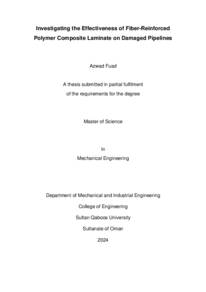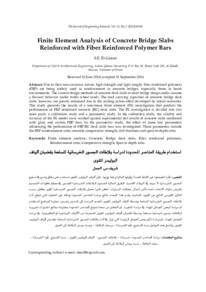وثيقة
Investigating the effectiveness of fiber-reinforced polymer composite laminate on damaged pipelines.
المصدر
Master's thesis
عناوين أخرى
التحقق من كفاءة استخدام البوليمرالمقوى بالألياف في اصلاح الأنابيب التالفة
الدولة
Oman
مكان النشر
Muscat
الناشر
Sultan Qaboos University
ميلادي
2024
اللغة
الأنجليزية
الموضوع
نوع الرسالة الجامعية
Master's thesis
الملخص الإنجليزي
Using Fiber reinforced polymer composite laminate to strengthen or repair damaged
pipelines has been widely adopted in Oil and gas industry. They have been proven to
be able to increase the operating pressure and the lifetime of the repaired pipe. Hence
it is very important to properly evaluate the performance of the composite laminate
repair. In this study, pressurized blister test was used to evaluate the effect of different
repair geometries on the Failure Pressure. First, a flat plate test specimen with a
circular through wall defect and GFRP composite laminate repair was prepared. Then
a blister test was conducted to study the interfacial debonding between the repair
laminate and steel surface. The different geometries experimentally studied are pipe
defect size, FRP repair thickness, fiber orientation, repair size and surface roughness.
Experimental results reveal that a larger defect size leads to a smaller failure pressure
whereas a larger repair thickness increases the failure pressure. Test results show that
defect size and the repair thickness greatly affect the repair performance. Whereas the
fiber orientation, repair size and surface roughness have minor effect on the failure
pressure. Furthermore the blister test represents a good and reliable alternative to
hydrostatic test in evaluating repair performance.
الملخص العربي
الانبوب المصلح .وبالتالي، من المهم جدا تقييم أداء إصلاح صفائح البوليمر المركبة بشكل صحيح .في هذه الدراسة، تم استخدام اختبار البثرة المضغوطة لتقييم تأثير هندسة الاصلاح المختلفة على ضغط الفشل .أولا،ً تم تحضير عينة اختبار لوحة مسطحة مع عيب دائري عبر الجدار وإصلاحه باستخدام صفائح البوليمر المركبة المصنوعة من البلاستيك المقوى بألياف الزجاج .ثم تم إجراء اختبار البثرة الضغوطة لدراسة فك الارتباط بين صفائح الاصلاح وسطح الفولاذ .العوامل المختلفة التي تمت دراستها .تجريبياً هي حجم العيب وسمك الاصلاح واتجاه الالياف وحجم الاصلاح وخشونة السطح تكشف النتائج التجريبية أن حجم العيب الاكبر يؤدي إلى ضغط فشل أصغر بينما يؤدي سمك الاصلاح الاكبر إلى زيادة ضغط الفشل .تظهر نتائج الاختبارات كذلك أن حجم العيب وسمك الاصلاح يؤثران بشكل كبير على أداء الاصلاح .في حين أن اتجاه الالياف وحجم الاصلاح وخشونة السطح لها تأثير طفيف على ضغط الفشل .تظهر النتائج أنه يمكن استخدام اختبار البثرة المضغوطة كبديل أرخص للاختبار الهيدروستاتيكي في تقييم أداء الاصلاح.
قالب العنصر
الرسائل والأطروحات الجامعية


